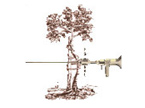Injuries of the anterior cruciate ligament (ACL) are thought to occur as frequently as 1 in 3000 people. The mechanism of injury is often a non-contact twisting of the knee that results in immediate pain and swelling. It has been estimated that there are over 100,000 ACL reconstructions performed each year in the United States and this number is reported to be increasing. ACL reconstruction surgery has a success rate of 80-90%. However, that leaves a substantial number of patients that have unsatisfactory results. Eight percent of these poor results are thought to be due to knee instability or re-rupture of the ACL graft. Failure of an ACL reconstruction is often hard to describe. The patient can have complaints of knee instability, pain, stiffness, or the inability to return to desired activities. Treatment for failed ACLs is complex and technically challenging, and the results of revision ACL surgery are not as good a primary ACL reconstruction. It is therefore important to follow a specific approach to evaluate, diagnose, and treat potential revision ACL cases.
There is no specific injury that leads to failure; however, the time failure occurred after surgery can help determine the cause of failure. Failures that occur within the first 6 months can be due to poor surgical technique, failure of graft healing, or too aggressive rehabilitation. Failures that occur after 1 year are usually due to another injury. Other factors that can lead to an unsatisfactory outcome are injury to other knee structures or leg alignment. Other structures injured in the knee may be the meniscus (lateral or medial) which acts as a shock absorber, or the cartilage on the ends of the femur (thigh bone) or the tibia (shin bone).
These injuries need to be evaluated and may need to be addressed at the time of repeat surgery if necessary.
Graft choices will be discussed and the type of graft chosen will depend on many issues, including tunnel placement, previous grafts used, or requirement for other surgeries. Options for using the patient’s own ligaments (autografts) include the patellar tendon, hamstring tendons or quadriceps tendon. Options for using donated ligaments (allografts) include Achilles tendons, patellar tendons, and tibialis tendons. All of the tissue processing companies are required to abide by strict standards and techniques to minimize risks of disease transmission. If the guidelines from the American Association of Tissue Banks are followed, the risk of disease transmission is estimated to be 1 per 1,000,000 cases. Many studies have been performed that have shown safe and successful use of allograft ligaments for ACL reconstruction. However, the tendon chosen will often depend on specific issues unique to each patient.
The rehabilitation for a revision ACL reconstruction is similar to the initial reconstruction, but may be more lengthy and less aggressive. It must be explained to patients that the results are less predictable than their initial surgery and it is very important that they followed the staged rehabilitation. Each rehabilitation program will be individualized to match the type of revision surgery, graft fixation, and additional surgery that the patient had. Weight bearing is often protected longer and return to sports is withheld compared to primary ACL reconstruction.
Revision ACL reconstruction is a complex undertaking and is recommended for patients that have instability both subjectively and objectively. The cause of the failure must be investigated carefully and will involved several studies that have been performed in the past. Preoperative planning is very important and may identify staged surgeries that will be performed before the revision ACL. The patient must understand that the results of revision ACL reconstructions are not as good as the initial ACL and the goal of the revision is to allow the patient to do their activities of daily living instead of return to competitive athletics. The patient should have realistic goals and understand all of the issues, but can be reassured that with the proper evaluation, treatment, and rehabilitation, a successful outcome can be expected in most cases.
– By Kenneth Westerheide, MD –


